Psych - U4 AOS 2
1/79
There's no tags or description
Looks like no tags are added yet.
Name | Mastery | Learn | Test | Matching | Spaced |
|---|
No study sessions yet.
80 Terms
Mental Wellbeing
Our state of mind, enjoyment of life, and ability to cope with everyday stressors and develop to our potential.
Functioning
Refers to how well an individual independently performs in their environment, varying in level or degree.
can be represented on a continuum
Level of Functioning
Corresponds to how well a person is meeting challenges across areas like
daily living skills,
interpersonal relationships,
emotions,
cognitive skills,
school/work,
leisure activities.
Mentally healthy people
typically have a high level of functioning in most areas
Adaptive Behaviour
Enables individuals to adjust to their environment appropriately and effectively, independently in various settings.
Maladaptive Behaviour
detrimental, counterproductive, or otherwise interferes with the individual's ability to successfully adjust to the environment and fulfill their typical roles in society
Disrupts + impairs everyday functioning
Resilience
The ability to cope with and manage change, 'bounce back' from adversity, restore positive functioning, and not fixed.
Characteristics of someone who is resilient include:
strong belief in their abilities to accomplish tasks and succeed
(i.e. high self-efficacy)
high self-esteem
approaching adversity with a sense of optimism, opportunity and hope
adaptable and flexible
organised
problem-solving skills
ability to make realistic plans and carry them out.
good social support systems
Social and Emotional Wellbeing (SEWB)
Describes the physical, social, emotional, spiritual, and cultural wellbeing of a person, particularly in Aboriginal and Torres Strait Islander views.
Seven Domains of SEWB
Connection to body and behaviours.
Connection to mind and emotions.
Connection to family and kinships.
Connection to community.
Connection to culture.
Connection to Country.
Connection to spirit, spirituality and ancestors.
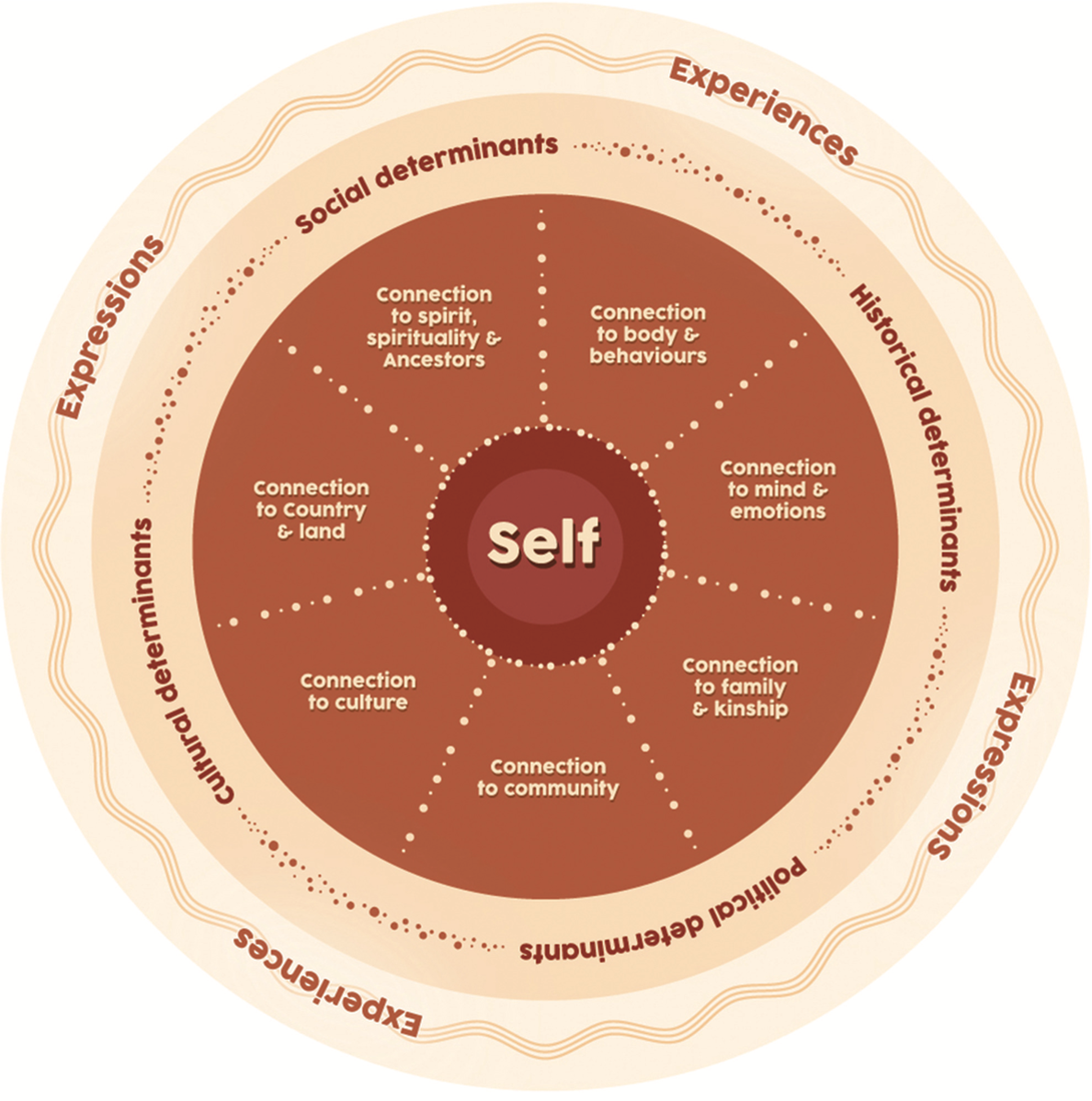
Connection to body and behaviours:
Involves all aspects of physical health and wellbeing,
especially feeling a strong and positive connection to one’s body
appreciating everything it allows us to do and experience in life.
Connection to mind and emotions
Emphasises the individual’s personal experience of their mental wellbeing (or mental ill-health)
their ability to manage thoughts and feelings.
Intimately linked with spirituality.
Connection to family and kinships:
Recognises that family and kinship systems have always been central to the functioning of traditional and contemporary Aboriginal and Torres Strait Islander peoples’ lives.
Connection to community
Emphasises a connection to a communal space that can take many forms and provides opportunities for individuals and families to connect with each other, support each other, and work together.
Connection to culture:
Refers to one’s secure sense of cultural identity and cultural values through connection to Aboriginal and Torres Strait Islander heritage.
Includes all knowledge systems, ways of knowing, and cultural traditions and practices.
Provides a sense of continuity with the past and helps underpin a strong identity.
Connection to Country:
Country refers to an area where Aboriginal and Torres Strait Islander people have a traditional or spiritual association and the deep sense of belonging this brings.
This domain recognises that the relationship with Country underpins all other forms of relational wellbeing.
Being on and caring for Country has positive physical and mental health outcomes for Aboriginal and Torres Strait Islander people.
Connection to spirit, spirituality, and ancestors:
Recognises the sacred and interconnective relationship between Country, human and non-human beings, as well as the past, present and future.
Includes knowledge and belief systems, and the Dreaming.
Mental Wellbeing Continuum
presents a continuum with three distinct categories:
mentally well, where individuals feel positive and function well;
a mental health problem, which is moderate in severity, temporary, and interferes with functioning;
diagnosable mental disorder, which is more serious, long-lasting, and may require treatment

Continuum Concept
Approach aiding in identifying early signs of mental health difficulties and promoting wellbeing.
suggest mental health is not ‘fixed’ and every changing
What is the mental health continuum, and how does it function?
shows mental wellbeing as fluid,
influenced by stressors,
helping identify early signs and promote wellbeing.
Internal Factors
Influences originating within a person,
categorized as:
biological (genes, neurotransmitters)
psychological (thinking patterns, perceptions).
External Factors
Influences from outside a person,
such as
interpersonal relationships,
education,
income,
housing,
cultural background.
Biological Factors as a part of internal factors in mental health and wellbeing
involve physiologically based or determined influences,
such as the genes we inherit, sex, balances or imbalances in specific neurotransmitters, brain and nervous system functioning, hormonal activities and fight-or-flight-or-freeze and other bodily responses to stress.
Psychological Factors
Influences related to mental processes including thinking patterns, beliefs, attitudes, emotional responses, respond to and manage stress, and reconstruct memories.
Stress
Psychobiological response to internal or external stressors, varying from daily hassles to traumatic events.
stress response that is experienced may be acute and short-lasting or chronic and long-lasting.
Anxiety
Common human response involving feelings of apprehension, often future-oriented, triggering physiological changes
Severe anxiety often involves intense physical symptoms like shortness of breath, sweating, trembling, and feelings of doom.
Persistent severe anxiety affects thinking, feeling, and behaviour, causing significant distress.
Prolonged anxiety may indicate an anxiety disorder, characterized by chronic worry and fear that impacts daily life.
Phobia
Irrational fear of a specific object, activity, or situation, leading to avoidance or distress.
fear response is disproportionate to the actual danger.
feared object or situation is known as the phobic stimulus.
classified as mental health disorders
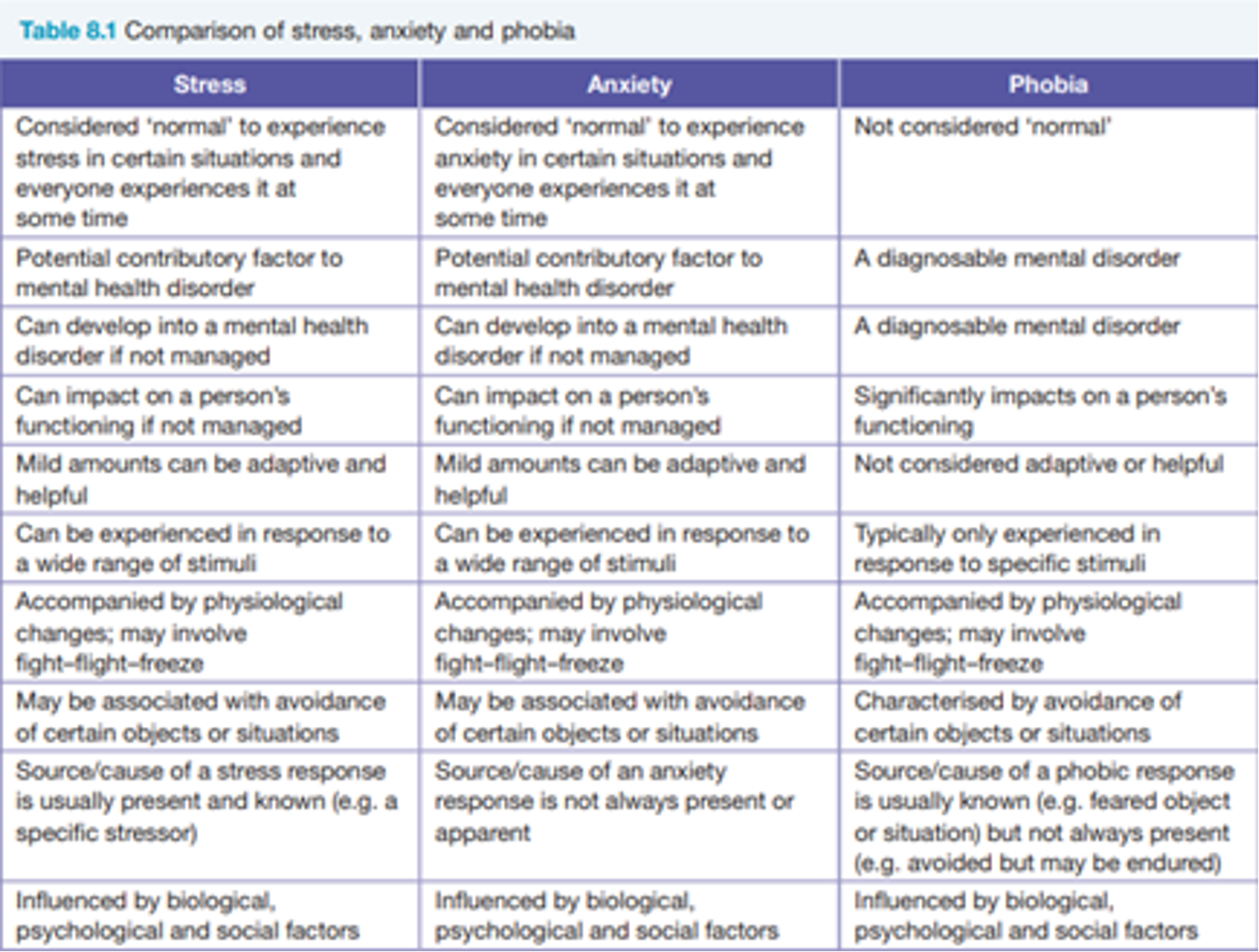
Specific Phobia
An anxiety disorder characterized by marked and persistent fear or anxiety about a specific object, activity, or situation.
out of proportion to the situation.
Panic Attacks
Sudden onset of intense fear or terror, often accompanied by physiological or psychological changes.
can be triggered by an obvious cue (expected) or occur unexpectedly without a clear cause.
Anticipatory Anxiety
Worry or apprehension about potential exposure to a phobic stimulus in the future.
often accompanied by somatic (bodily) symptoms of tension
Biopsychosocial model
Reflects a holistic view of mental health and wellbeing
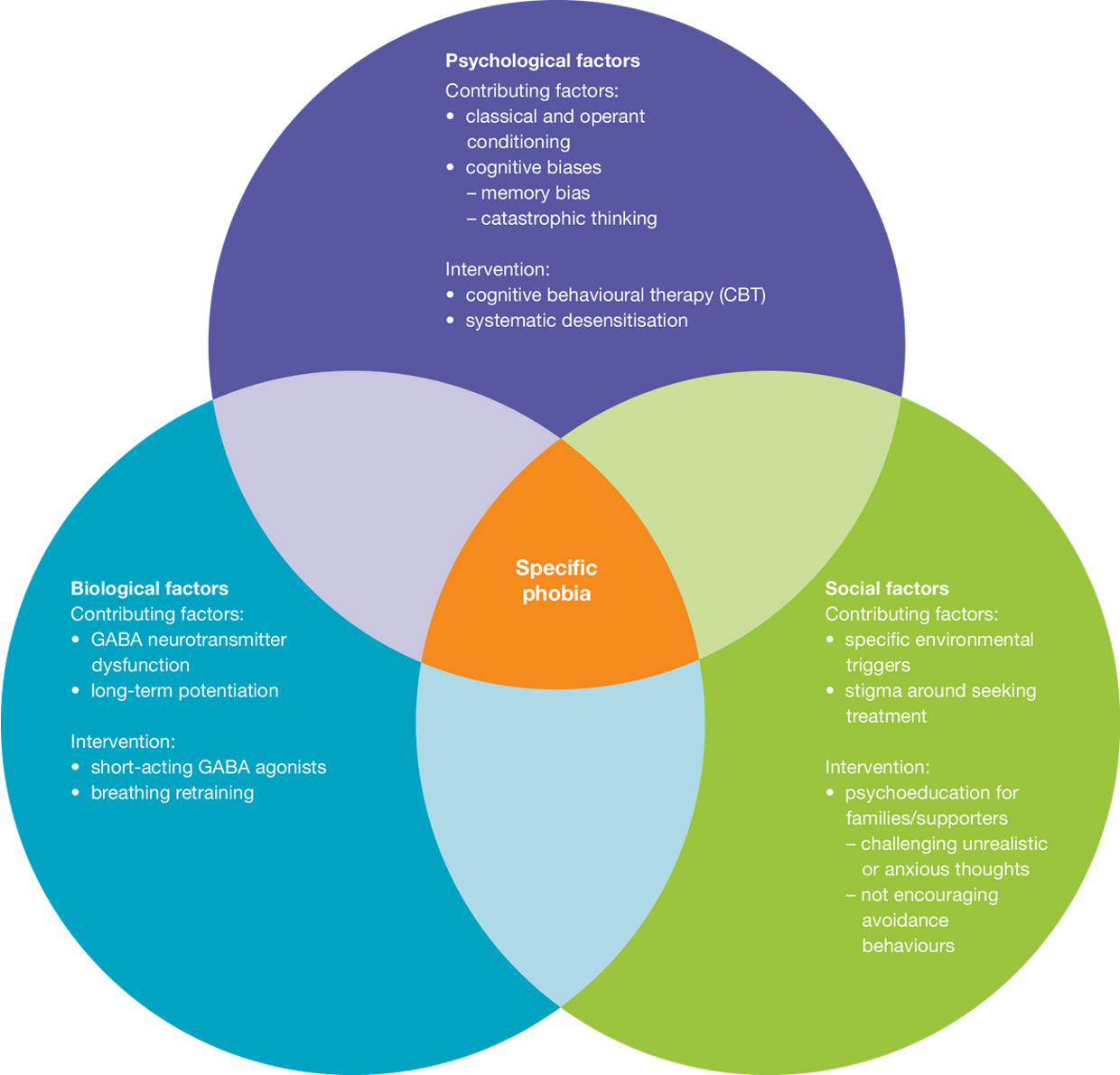
Biological factors impacting specific phobia
GABA dysfunctioning
Long-term potentiation
GABA
An inhibitory neurotransmitter, making postsynaptic neurons less likely to be activated; dysfunction can lead to seizures and anxiety disorders
What happens w/out GABA
Seizures: activation of postsynaptic neurons might get out of control and spread across the brain.
Anxiety Disorders: failure to produce, release or receive the correct amount of GABA needed to regulate neuronal transmission in the brain.
Predisposition for specific phobia: fight-or-freeze response may also be more easily triggered
What causes GABA dysfunction?
genetic inheritance
CNS damage
exposure to prolonged stress
nutritional deficiencies in vitamin B6 and citric acid
high caffeine intake.
Long-term potentiation
Enables neural plasticity, supporting learning and memory; strengthens synaptic connections and contributes to the development of specific phobias
can strengthen the association between a phobic stimulus and a fear or anxiety response.
Psychological factors impacting specific phobia
Behavioural Models:
Precipitation by CC
Perpetuation by OC
Cognitive biases:
Memory bias
Catastrophic thinking
Precipitation by Classical Conditioning
explains how a neutral stimulus can become a phobic trigger when paired with an anxiety-provoking event.
The phobic stimulus (previously neutral) elicits a fear response after being associated with a frightening or traumatic experience.
This learned association leads to the development of a specific phobia, as the individual now anticipates fear upon encountering the phobic stimulus.
Perpetuation by Operant Conditioning
After acquisition through classical conditioning, the phobia can be maintained and therefore perpetuated by operant conditioning.
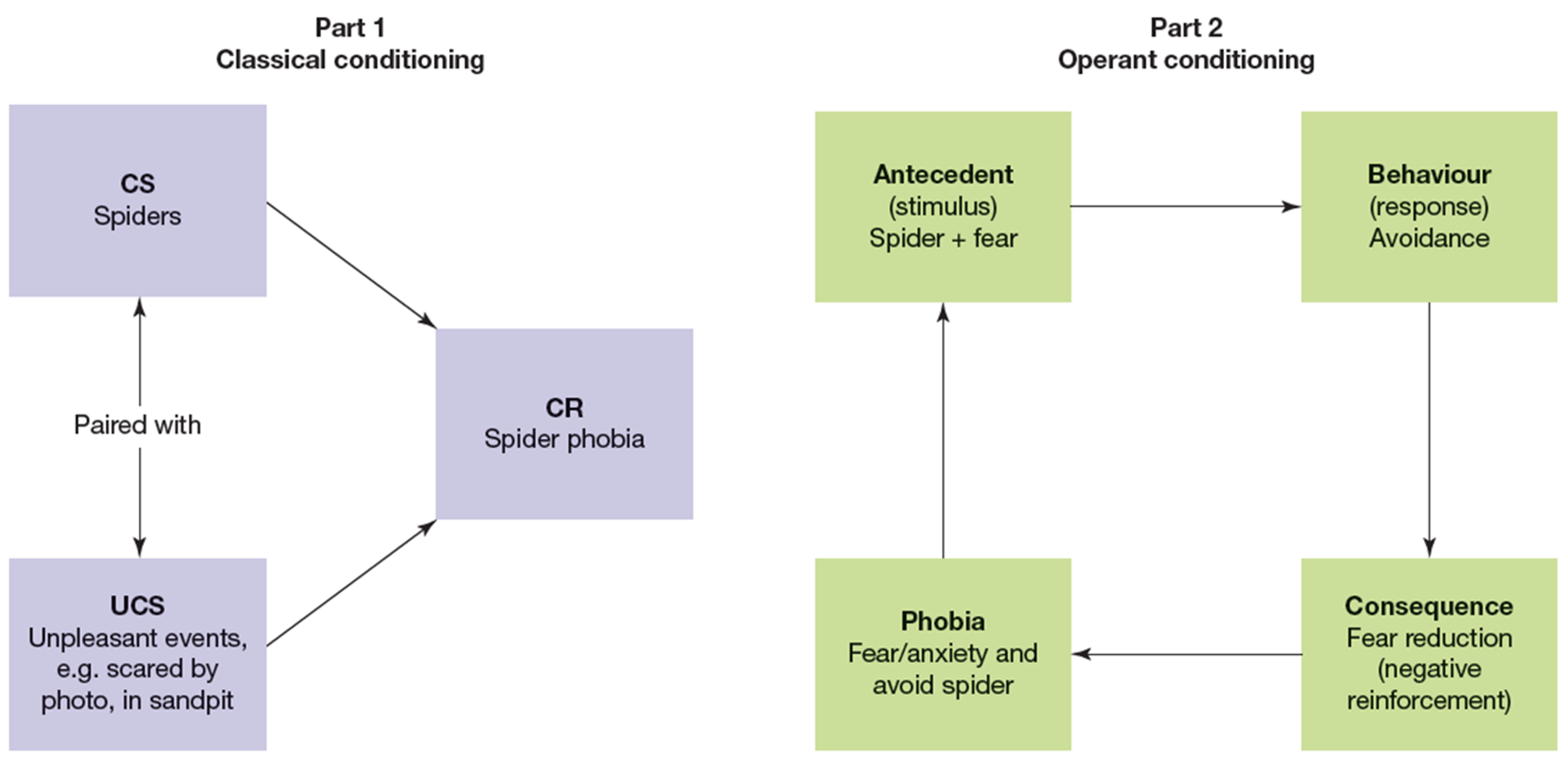
Behavioural Models
Assumes phobias are acquired through classical conditioning and maintained through operant conditioning
Cognitive biases
Systematic errors of thinking affecting decisions and judgments, leading to inaccurate conclusions; includes memory bias, consistency bias, and change bias
Memory bias
refers to the distorting influences of present knowledge, beliefs and feelings on the recollection of previous experiences
Catastrophic thinking
Assuming extreme negative outcomes when exposed to a phobic stimulus, leading to heightened feelings of helplessness
heightened feelings of helplessness and grossly underestimate their ability to cope with the situation.
Social factors impacting specific phobia
Specific environmental triggers
Stigma around seeking treatment
Specific environmental triggers
Direct negative or traumatic experiences with phobic stimuli that contribute to the development and maintenance of phobias
Stigma
Social disapproval or deficiency, often involving shame or disgrace
Social stigma
Negative attitudes and beliefs in the wider community leading to discrimination against individuals with mental health problems
Evidence-based interventions in the treatment of specific phobia
Treatments proven effective by scientific evidence, crucial for mental health care delivery
Biological interventions
Target bodily mechanisms contributing to phobias; can involve medications targeting GABA dysfunction and relaxation techniques (breathing retaining)
Anti-anxiety benzodiazepine agents
Benzodiazepines are anti-anxiety drugs that act on the CNS.
They enhance GABA's inhibitory effects, reducing neuron excitation and slowing brain activity.
they only treat symptoms. Anxiety may return if the underlying phobia is not addressed.
What role do benzodiazepines play as GABA agonists?
have inhibitory effects on postsynaptic neurons throughout the brain and reduce the symptoms of anxiety by imitating GABA’s inhibitory effects.
When it attaches to a GABA receptor, it changes the shape of the receptor to make it more receptive to the activity of GABA and consequently more resistant to excitation.
classifications of benzodiazepines based on duration in the body?
Classified as short, intermediate, or long-acting, depending on how quickly they are cleared from the body.
Benzodiazepine antagonist
A substance that reduces GABA activity, potentially increasing anxiety symptoms by countering the effects of benzodiazepines.
Breathing retraining
An anxiety management technique that corrects breathing habits, reducing anxiety symptoms by maintaining proper respiration rates.’
Respiration rate affects heart rate, blood pressure, and other functions. Slow, regular breathing promotes relaxation, lowers arousal, and reduces anxiety and stress.
Types of psychological interventions for treating phobia
CBT (cognitive-behavioural therapy)
Systematic desensitisation
Cognitive behavioural therapy (CBT)
A psychotherapy combining cognitive and behavioral therapies to address phobias and mental health disorders by modifying thoughts and behaviors.
individuals identify fear- and anxiety-related thoughts, replace unhelpful thinking with adaptive thinking, and reduce fear and anxiety.
Systematic desensitization
A behaviour therapy technique that involves unlearning the connection between anxiety and a specific object or situation and re-associating feelings of relaxation and safety with that object or situation.
To desensitise the individual to the phobic stimulus, so they can eventually face the most anxiety-producing situations in a relaxed state.
Three-Step Process of Systematic Desensitisation
Relaxation Training: Teaches the individual a relaxation technique (e.g., controlled breathing exercises) to reduce anxiety.
Fear Hierarchy: Breaks down the phobic stimulus into a sequence from least to most anxiety-producing, creating a list ranked by anxiety level.
Graduated Exposure: Systematically pairs relaxation with the fear hierarchy, exposing the individual gradually, either in real life, through imagination, or using virtual reality. Progresses through each step only when relaxation is achieved.
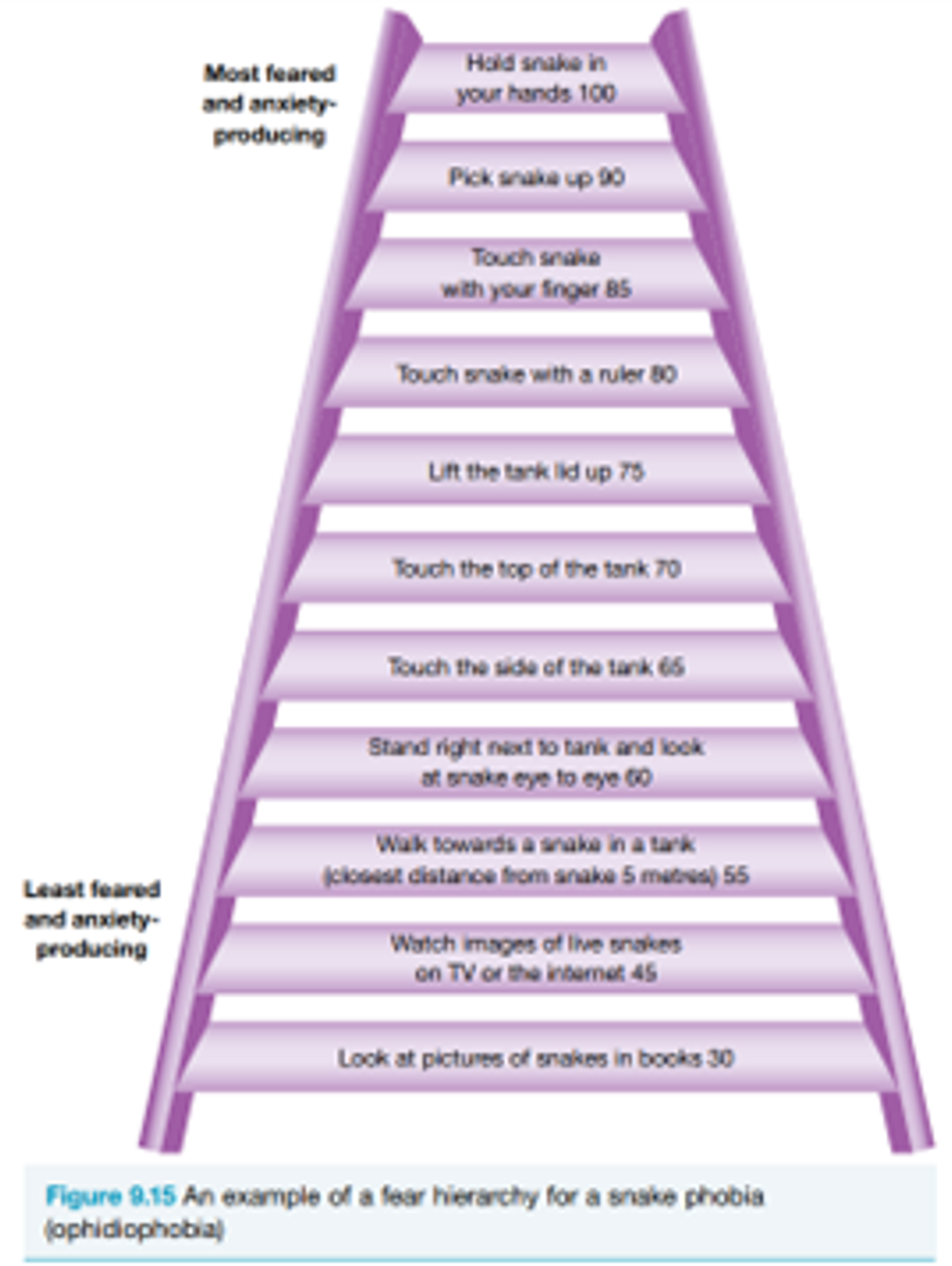
Types of social interventions for treating phobia
Psychoeducation for friends, families, and supporters
Psychoeducation for families and supporters
Psychoeducation:
A form of education that provides information to individuals about their specific phobia to help them understand its characteristics and treatment options
Anxious Thoughts
People with a specific phobia often have negative and unrealistic thoughts about their feared stimulus.
Cognitive Distortions
Thoughts involving overestimating the danger of a feared situation and underestimating one's ability to cope.
Challenging Thoughts for specific phobia treatment
Learning to challenge these unhelpful thoughts is crucial for overcoming a phobia, although it can be difficult when feeling anxious or distressed.
Role of Supporters in treating specific phobias:
Family members and supporters can help by encouraging the person to identify and challenge these unrealistic or anxious thoughts.
Natural Avoidance
Tendency to avoid feared objects or situations causing anxiety, hindering phobia recovery.
Protective factors
Enhancements that protect mental wellbeing and reduce the likelihood of mental ill-health.
Risk factors
something that increases the likelihood of experiencing mental ill-health, or can make existing mental health difficulties more severe or long lasting.
Biological protective factors
Factors related to physical health, such as adequate nutrition, hydration, and sleep.
Psychological protective factors
Cognitive behavioural strategies
Mindfulness meditation
Cognitive behavioural strategies: Cognitive Restructuring
Techniques to address negative, irrational thinking that can harm mental well-being.
Steps:
Identify Negative Thought: can use a journal or thought record.
Identify Emotions and Behaviors that occurred
Challenge the cognitive distortion or negative thought
Behavior Activation
Using behavioral strategies to enhance mental wellbeing through behavior change.
Meditation:
Involves sitting quietly, turning attention inward, and focusing on something specific.
Mindfulness:
Involves paying full attention and being present in the moment, experiencing things as they are
Mindfulness Meditation
Practice involving focused attention on breathing to enhance mental wellbeing.
Culture
The way of life of a particular group, society, or community, that sets it apart from the others
encompassing language, customs, beliefs, and more.
Cultural determinants
protective factors that maintain connections to culture, strengthen identity, enhance resilience, and support good mental well-being.
Impact of Culture for Wellbeing of Aboriginal and Torres Strait Islander Peoples
Strengthens identity, self-esteem, and acts as a buffer against risks to mental health.
Cultural continuity
Maintaining a connection to culture, Country, and community for better mental wellbeing (SEWB)
essential for mental wellbeing and passing cultural knowledge to younger generations.
Provides a sense of history, identity, and belonging; supports resilience and mental health.
Self-determination
another protective factor for the mental wellbeing of Aboriginal and Torres Strait Islander people.
the state of being free to control one’s own life. When applied to Aboriginal and Torres Strait Islander communities, self-determination refers to the right to freely determine or control their political status and freely pursue their cultural, social and economic development
Why self-determination works
works
Ab. and Torrest Strait Islander people have a right to self-determination
‘‘‘ have requested self-determination